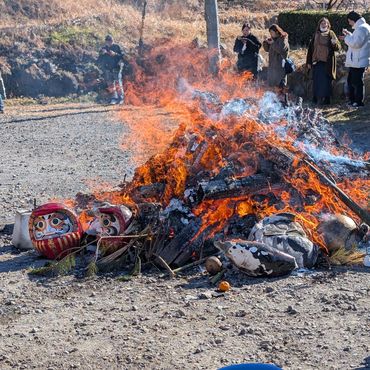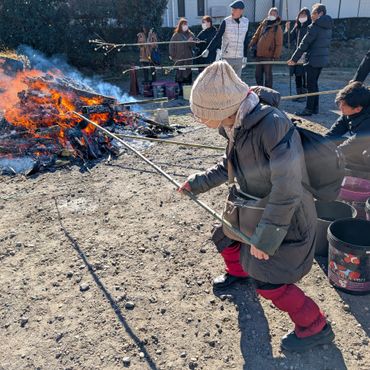翻訳:

Akkun’s FOCUS vol.13
DASHI-tasty and healthy Japanese stock
If you love Japanese food, you must know how important and fundamental Dashi is.
Dashi is Japanese basic stock with fermented bonito flakes and kelp. It has subtle taste
and makes every dish magically delicious by its basic UMAMI which is the delicate Japanese tastes to vital all the elements of ingredients.
Barrier is the Japanese Kaiseki restaurant in Kanazawa which puts DASHI as the main factor of their courses. You are supposed to pour the best hot DASHI to all the dishes in front of you and find how successfully the dashi makes the difference of taste of all the foods.
Here you can clarify the role of DASHI and balance your body by taking the finest DASHI of Japan. When you feel tired or stressful, that is the best way to relax and take back your energy. If you like to have some SAKE, it helps to make you happier, too.
When I lead long tour and came back home, the first think I would do is to tell the truth, taking DASHI in my kitchen to make tasty Miso soup. I feel completely relaxed after sipping some. What I like is the combination of Daikon radish and Fried Tofu for Miso soup.
I’m planning basic Japanese cooking lecture in Kyoto. If you are interested in taking the best DASHI by yourself and enjoy this elegant way of balancing body, join me in future.
Video

Akkun’s FOCUS vol.12
Dondo-yaki : Fire ritual in early spring
In Japan, fire is the sign of welcoming spring. The fire purifies entire area including people live there to welcome new spring or traditionally, new year.
Customary on 15 January, people gather the nearby open space, usually in a shrine of Ubusuna-gami, region deity, and make a big fire by burning the old good luck charms, such as Darma figure, paper talisman, etc. to change them all to the brand-new ones. The highlight is not making a fire itself. When the fire is getting weaker at the end, people come near the fire and start grilling Mochi, rice cake, on the branch. It is delicious! On still a cold day, if you make a bite of just grilled Mochi, you are in heaven.
This Mochi is not just rice cake. It is considered medicine to prevent any diseases for a year.
Yes, it is like a tasty vaccination for free without any pains. Quite often, hot and tasty sweet bean soup is provided beside this ritual fire. Everyone becomes happy indeed after grilling both Mochi and his face (it is really hot when you grill your Mochi on a stick by the fire).
Dondo-yaki has regional variations. It might be called Sagicho, Saito-yaki, Onibi-yaki, Dosojin festival and so on.
Whatever it is called, it tells the approaching spring is not so far. Everyone feels he/she is purified completely to welcome the new warm spring without any illness.
Video




Akkun’s FOCUS vol.11
A cup of green tea for 100
My grandmother loved to have many cups of green tea daily and enjoyed 102-year healthy life. This is a short introduction to a cup of green tea to you for your longevity.
My grandmother, Harue, liked to drink Sencha, which is leaf tea for daily use. Harue grew green tea trees by herself, early summer, she picked up the fresh tender leaves of tea and
asked to make nice green tea, Sencha, to nearby tea factory. I remember how tasty it was. It was sweet, gently bitter and refreshing, quite different from usual Sencha which I purchased at a supermarket. It is easy to understand why Harue only stuck to her own Sencha throughout her long healthy life by drinking this Harue tea by her strawberry patterned tiny teacup.
Would you like to try some, of course? OK, then come and visit Kyoto to go to a prestigious tea shop such as Fukuju-en, Ippo-do and Ryuou-en. Then buy two different kinds of tea. One is as your daily beverage and the other is for your holiday or special guests of you. It is high quality Sencha and Gyokuro combination. It gives your life a creative change.
To make Sencha, you need higher water temperature about 80℃ while 50℃ is suitable for Gyokuro. Gyokuro tea leaves are grown by covering the trees by black sheet to avoid strong sunshine. It makes a cup of tea delicate and mild like first flush extra Darjeeling.
Harue probably smiles at you and says, “A cup of green tea will give you a deep happiness.”

Akkun’s FOCUS vol.10
Dragon dance 'Shishi mai', during Japanese traditional festival
When all things have gone wrong, we need a change. If it is not a big deal, then a cup of tea or a glass of wine might work daily. But if the problems were serious, what would you do?
In Japan, Dragon dance or 'Shishi mai 'in Japanese, would work to make everything positive again. The dance purifies the whole town and people’s mind for the better future. It prevents or cleans pandemic, bad luck, fire, incidents, etc. all the negative factors in society.
The origin seems to have been very long time ago, in 1st century China, then introduced to Japan via Koria. The south Asian countries have similar dragon dancing. In Nagasaki, there’s a dynamic dragon dancing during the festival which is closer to the Chinese one.
If Shishi mai dancers come close to you, you are suppose to let the dragon bite your head which is a means of exorcism. Usually, mothers like to let their babies head get bitten by the dragon for the babies’ health and happiness. As you assume, the babies hate it. Therefor it becomes a common scene during the festival that lot of crying babies are in front of Shishi mai! People laugh at it and feel much better by watching it.
Dragon dance is also welcomed to the opening ceremony of a store or new house to purify the new location. It discourages all the evil spirits around the place.
Shishi mai hit a period on Covid 19. Whatever happens in future, as far as we keep Dragon dance tradition, we must be all right. Why don’t you join Japanese autumn festivals?




Akkun’s FOCUS vol.9
Buddhist monk Kukai, the religious superstar in Japan
Kukai is the name of a famous Buddhist monk who founded Mt. Koya ('Koya-san', in Japanese). It literally means “Sky and Sea”. Kukai’s heart was BIG just like his name. He lived in 8~9th century and people believe that Kukai is still alive and meditating in Mt.Koya.
He was born in Shikoku Island. He studied in Nara, the capital of Japan at the time to become a bureaucrat. But he was not interested in government official life. He eventually focused on esoteric Buddhism. Kukai meditated, abstained from food often, trained in deep mountain areas of Shikoku and the Kii Peninsula.
One day he came across one sutra which showed the way to attain the enlightenment. It tells the secret to know the fundamental essence of esoteric Buddhism. Kukai went to China to study more of it. In China, Monk Keika was waiting for someone suitable as his successor. When Keika met Kukai, the old master knew that he finally found the right person as his successor. Kukai came back to Japan to save all the spirits of this country and worked hard only for this purpose. One day he stopped taking food completely and moved on to the stage of eternal meditation.
Once a monk came into his meditation room. Kukai was alive. His face was shiny and kept pinkish colour and his black hair had become 10m long behind him! In Koya-san, Odaishi-sama, the nickname of Kukai, stays there on rainy days. People still feel Kukai’s life and work closely and directly through their pilgrimage with hope and appreciation. Kukai seems to go beyond religious barriers, since his philosophy might have included Christianity in Tang dynasty.





Copyright ©Kingfisher JAPAN KK - All Rights Reserved.
Kingfisher JAPAN KK follows